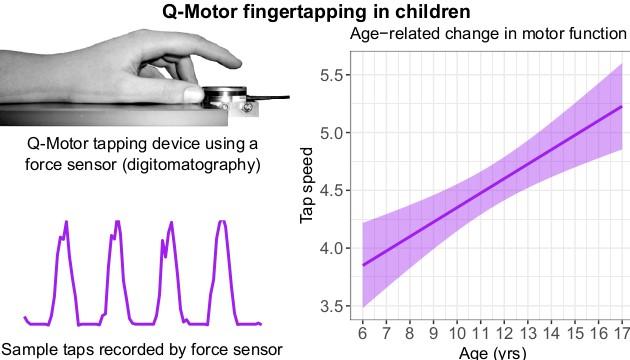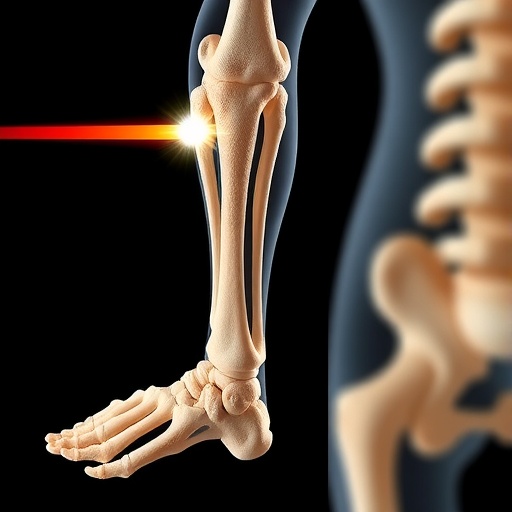Having a test to measure subtle changes in motor ability in young children

Credit: National Institute of Neurological Disorders
Amsterdam, NL, October 22, 2019 – In clinical trials of adults with Huntington’s disease (HD) the Q-Suite Motor Assessment Tool (Q-Motor) has proven to be helpful to detect and quantitate subtle motor abnormalities. With the anticipated arrival of preventive gene therapies that will most likely be administered to young children known to be carriers of the HD mutation, it is crucial to have a means to evaluate motor abilities in children that is sensitive to the child’s stage of development. Promising results of a feasibility study published in the Journal of Huntington’s Disease, indicate that Q-Motor can address this need.
“We found that we can get reliable, quantitative measures of motor function in children with Q-Motor and that the equipment is sensitive to age-related improvements in motor function. The assessments are non-invasive and easy to administer, allowing us to closely monitor small deviations in motor development that may eventually help guide us in deciding when to implement gene knock-down therapies,” explained lead investigator Ellen van der Plas, PhD, Department of Psychiatry, University of Iowa Hospital and Clinic, Iowa City. Another advantage, she added, is its widespread availability in HD testing centers.
The Q-Motor test uses force transducers to evaluate tapping speed and regularity. In this study, the investigators measured index finger tapping although the test is capable of also measuring tapping by hands or feet. Using additional 3-D position sensors, the test can also measure grasping and lifting abilities and involuntary repetitive and jerky choreiform movements.
In this study, 29 children ranging in age from 6 to 17 years old were tested with Q-Motor. They were recruited from the general population and were not HD carriers. All of the children were able to follow instructions to complete the Q-Motor tasks. Overall older children are faster and more regular tappers than young children.
Dr. van der Plas noted that Q-Motor is not yet validated or accepted by regulatory agencies, unlike the gold standard Unified Huntington’s Disease Rating Scale Total Motor Score (UHDRS-TMS). “However, our results imply that various motor functions covered by Q-Motor are sensitive to developmental changes in childhood, making it a suitable measure for studying subtle motor manifestations of HD in at-risk youth that can be used for proof-of concept studies,” said Dr. van der Plas.
“The HD community is embarking on clinical trials evaluating the efficacy of huntingtin-lowering therapies for the treatment of patients in the early phases of disease. The ultimate goal for the HD community is to implement preventive treatments that ensure that disease manifestations in gene-expansion carriers can be delayed, or that affected individuals can live their lives free of HD,” added co-author Peggy C. Nopoulos, MD, Professor of Psychiatry, Neurology and Pediatrics, Department of Psychiatry, University of Iowa Carver School of Medicine.
HD is a genetically inherited autosomal dominant neurocognitive disorder. Although it can affect peripheral nerves, the most vulnerable areas of the brain are the nerve cells (neurons) of the cortex and striatum. HD is caused by mutations in the Huntington’s gene, HTT, which directs the production of the protein huntingtin. The DNA of people with HD shows abnormal repetitions of certain DNA building blocks composed of cytosine, adenine, and guanine (CAG), and the number of CAG repeats is indicative of disease severity. Early signs of HD include personality changes, mood swings, depression, forgetfulness, and impaired judgment. Over a period of 10-25 years, patients begin to manifest symptoms such as unsteady gait and involuntary movements (chorea), and eventually slurred speech, difficulty in swallowing, loss of mobility, and significant weight loss. A child born to a parent who carries the HD mutation has a 50% chance of developing the disease.
###
Media Contact
Diana Murray
[email protected]
718-640-5678
Related Journal Article
http://dx.




